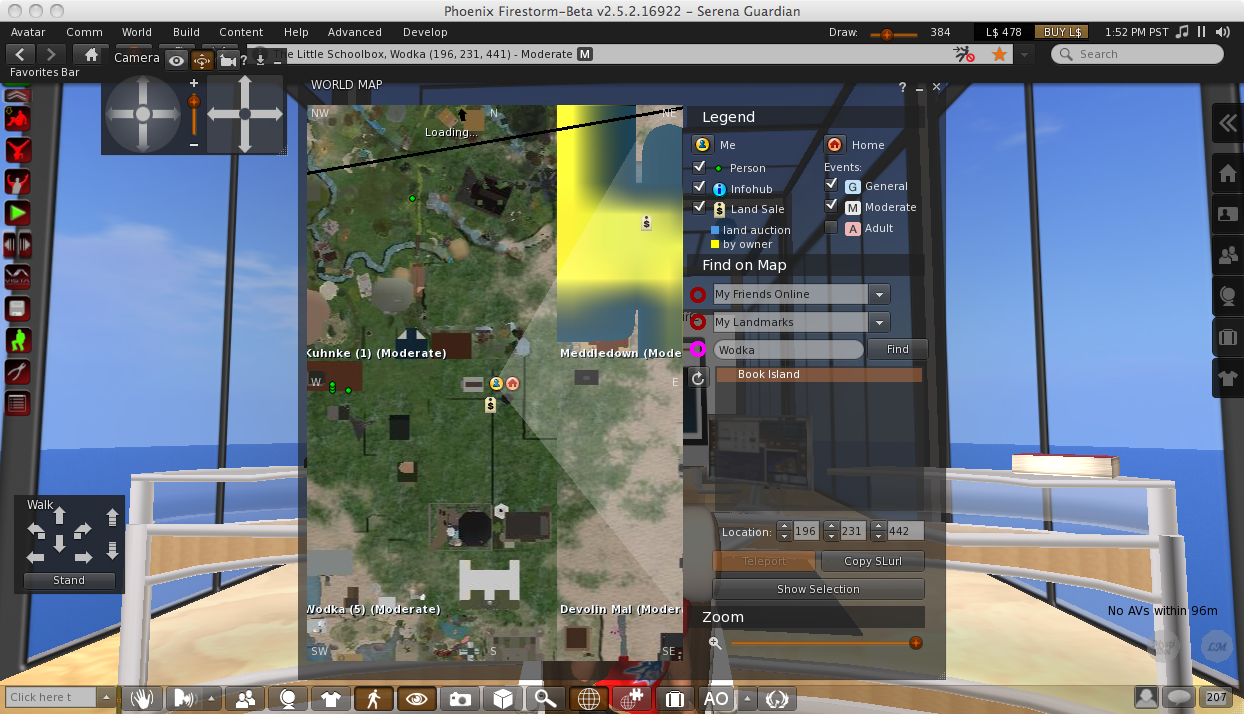Notes and Works Cited
Visit the author's Second Life office by clicking on this image or this link. It will prompt you to create a basic Second Life account if you don't have one and to install the viewer.
Notes
1 A colleague suggested to me that an institutional raison d'être needs to be found before individual instructors and students can benefit from Second Life, and I agree because Second Life is not something one masters as an add-on in a week to an already full course curriculum—it has implications for use well across and even beyond the curriculum. Local and occasional use of the program may not do any damage, but is likely to fail as an effective educational platform. This is my reason for connecting it with ePortfolio learning, which has similar implications and also needs system-wide support to achieve its fullest potential. For more information on the documented benefits of ePortfolio learning, investigate the Making Connections project at Laguardia Community College in New York. Also see Kathleen Blake Yancey’s “Electronic Portfolios a Decade into the Twenty-First Century: What We Know, What We Need to Know” from Peer Review (Winter 2009), cited in this article, and “Postmodernism, Palimpsest and Portfolios: Theoretical Issues in the Representation of Student Work” (College Composition and Communication 55.4, June 2004).
2 I prefer the inter-participant feedback system developed by Jane McGonigal for Urgent EVOKE over a simpler system of assigning points to a build (1-5 stars, for example). Urgent EVOKE, a social innovation web-based game, allows participants to rate each other’s contributions for characteristics (collaboration, creativity, knowledge share, resourcefulness, sustainability, courage, entrepreneurship, local insight, spark, and vision). The points (called EVOKE Powers) accumulated in each category appear in the participant’s profile. Specific assignments (called Missions) contribute more heavily to specific characteristics. For example, the accomplishment of a mission called Food Security is worth points from the game for local insight, spark, and vision after completion, but individual players may continue to assign EVOKE Powers to a contribution in whatever category they see fit. The game defines EVOKE Powers as “the core skills, abilities, and talents that make successful social innovation possible. In other words, they are the key social innovation superpowers.” There’s nothing to prevent customization of such a system to award “rhetorical superpowers,” some of which are already embedded in the EVOKE system (such as knowledge share, creativity, vision), or other general or discipline-specific powers.
** Special thanks to Sandra Stelmach **
Works Cited
Anabuki, Chenin et. al. Avatrian: Portfolio. 2006. Web. June 24, 2011.
Bolter, Jay Robert and Richard Grusin. Remediation: Understanding New Media.
Cambridge MA: MIT Press, 2000. Google edition. Web. June 24, 2011.
D. H. “The Ten Principles.” Burn2. February 28, 2011. Web. June 24, 2011.
Field of Dreams. Dir. Phil Alden Robinson. Perf. Kevin Spacey, James Earl Jones, and Ray Liotta. Gordon Company, 1989. Web (IMDB).
Haraway, Donna. "A Cyborg Manifesto: Science, Technology, and Socialist-Feminism in the Late Twentieth Century." Program in History & Philosophy of Science & Technology, Stanford University. Reprinted from Simans, Cyborgs, and Women: The Reinvention of Nature (Routledge, 1991), pp. 149-181. Web. December 12, 2001.
Inman, James A. Computers and Writing: The Cyborg Era. London: Routledge, 2004.
Print. Also available in a Google edition.
KirkwoodSLGroup. “Vassar 07 Sistine Chapel Vassar College Second Life Tour.”
YouTube. February 9, 2009. Web. June 24, 2011.
Malaby, Thomas M. Making Virtual Worlds: Linden Lab and Second Life. Ithaca NY:
Cornell UP (2009). Kindle edition. Web. June 24, 2011.
McGonigal, Jane (as Alchemy). “Five Secrets of the EVOKE Network.” Urgent EVOKE.
2010-2011. Web. June 24, 2011.
McLuhan, Marshall. Understanding Media: the extensions of man. 2nd ed. (Google Books ed). Routledge: 2001. Web. December 12, 2011.
"Multi-User Dungeons (MUDs)." The Living Internet. 2000-2011. Web. December 12, 2011.
Regis University Portfolio Project. "e-Portfolio Basics: Types of e-Portfolios." 2003. Web. December 13, 2011.
Schirmer, James Robert. Acquiring Literacy: Techne, Video Games and Composition
Pedagogy. Dissertation. Advisor Kristine Blair. Bowling Green State University, 2008. OhioLINK ETD Center, document # bgsu1211307417. Web. June 24, 2011.
Sofia, Carolyn. Personal e-mail message. Web. June 27, 2011.
Yancey, Kathleen Blake. “Electronic Portfolios a Decade into the Twenty-First
Century: What We Know, What We Need to Know.” Peer Review (Winter 2009): 28-32. Web. June 24, 2011.
“What is Burning Man?” Burning Man. Web. June 24, 2011.
Additional Links
Websites and YouTube Videos
Adobe Dreamweaver (website, web development software)
Alamedia County Virtual Polling Place (YouTube, Avatrian project)
Ball State University (website, real place)
Blackboard, Inc. (course management system software, website)
Blue Mars (website, virtual world)
Digication (website, ePortfolio program)
Entropia Universe (website, game)
Facebook (website, social networking site).
FRAPS (screen capture software, website)
Institute for Digital Intermedia Arts at Ball State University (website)
Intellibook Factory Tutorial (YouTube).
iShowU (screen capture software, website)
LSL Tutorial (website, Second Life wiki)
Lambda MOO (server software, website)
The Medieval Corridor (website, Avatrian project)
Moonworld (website, Avatrian project)
OpenSimulator (website, virtual world software)
RMB City (website, Avatrian project)
Second Life Marketplace (shopping website for virtual goods, scripts, and tools)
Snougle Comics by Troy McConaghy (website, Avatrian project)
The Terrain Factory (website, Avatrian project)
UCF Voting Center (YouTube, Avatrian project)
Vassar College (website, real place)
The Winter Playground (YouTube, Avatrian project)
Wordpress.com (website, blogging site)
World of Warcraft (website for game)
Virtual Places (to Visit in Second Life)
Ball State University Island region, Second Life (sURL)
Book Island, Second Life region (sURL).
Leviathan of Parsonsville at Space Island, Second Life Region (sURL, Avatrian project)
Second Life Seawolves parcel on SUNY Learning Network island, Second Life (sURL)
Virtual Sistine Chapel, Vassar Island region, Second Life (sURL)
All photos by the author unless otherwise indicated.

